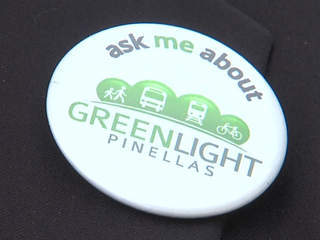Backers of the Greenlight Pinellas project propose to build a 24-mile light-rail line from downtown St. Petersburg to Clearwater, Florida. This would be a disaster for transit riders, taxpayers, and auto drivers in the region.
Suppose someone offered you a new transportation technology that will cost 50 times more than starting up a new bus service, cost twice as much to operate and maintain as buses, and only be capable of carrying fewer people per hour than buses.
That is what light rail is all about.
Low-Capacity Transit
Contrary to claims that light rail is “high-capacity transit,” the “light” in light rail refers not to weight but to capacity: light rail means low-capacity rail transit.
Light-rail trains can usually be no longer than three cars, each holding up to 150 people. For safety reasons, tracks can carry only about 20 trains per hour, meaning light rail can move about 9,000 people per hour.
By comparison, a single bus stop can serve more than 40 buses per hour, and by staggering bus stops, a city street can serve more than 160 per hour. Standard buses have about 40 seats and room for 20 people standing, making it possible to move more than 10,000 people per hour. If that’s not enough, double-decker buses can move 18,000 people per hour.
$50 Million a Mile
Light rail is enormously expensive, costing an average of $50 million per rail mile, and the vehicles cost about $4.5 million each. Buses share the cost of streets with cars and trucks, and each bus costs on average only about $400,000 ($700,000 for double-decker buses).
Immediately after a light rail system is built, maintenance costs are low, but those costs grow rapidly as infrastructure ages. American rail transit systems have a $60 billion maintenance backlog that is growing because agencies don’t have enough money to keep systems in shape.
When systems are operating at capacity, more than half of light-rail riders have to stand, clinging to straphangers, whereas 80 percent of bus riders get to sit comfortably. New buses may be equipped with power ports at each seat, on-board Wi-Fi, and other amenities to attract riders.
Moreover, buses can go anywhere streets go, which means once they leave city centers, they can fan out to many neighborhoods. Trains go only where rails go, forcing most riders to switch to a car or bus to get to their actual destination.
More than a dozen people die in light-rail accidents per billion passenger miles carried, compared with just four fatalities in bus accidents.
Dirtier Than Average SUV
Light rail is powered by electricity, and most electricity in the United States comes from burning fossil fuels, so this mode of transportation isn’t particularly green. Light-rail lines in Baltimore, Buffalo, Cleveland, Dallas, Norfolk, Pittsburgh, and Salt Lake City use more energy and emit more greenhouse gases, per passenger mile, than the average SUV.
Proponents claim light rail contributes to economic development. In fact, nearly every light-rail city has had to subsidize development along the light-rail route. These subsidies typically come from property taxes that otherwise would have gone to schools, libraries, fire departments, and other services.
Given all these problems, why do so many cities want to build rail? The answer is a federal fund called New Starts, which promises to cover at least half the cost of new transit lines, and cities that spend more get more. Thus, cities race to build the most expensive lines possible.
Ongoing Costs
Though the feds may pay half the capital costs, local taxpayers must pay not only the other half but also most operation and maintenance costs. These high costs have forced many transit agencies to cut bus service, harming transit riders.
The race to build light rail is a race to waste money. Pinellas County and other jurisdictions around the country should stay out of this race and stick to comfortable, affordable bus service.
Randal O’Toole ([email protected]) is a senior fellow with the Cato Institute and author of “The Worst of Both: The Rise of High-Cost, Low-Capacity Rail Transit.” Used with permission of Watchdog.org.
Internet Info
“The Worst of Both: The Rise of High-Cost, Low-Capacity Rail Transit,” Randal O’Toole, Cato Institute: http://heartland.org/policy-documents/worst-both-rise-high-cost-low-capacity-rail-transit



